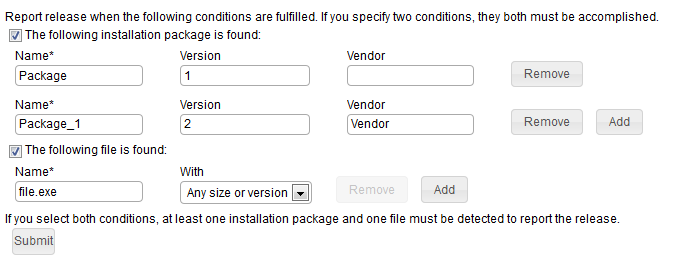Creating signatures
You can use the built-in functionality to extend your custom catalog with the software products that are installed in your infrastructure but are not present in the HCL® catalog.
Before you begin
 You must have the Manage Catalogs permission to perform this task.
You must have the Manage Catalogs permission to perform this task.Procedure
- In the top navigation bar, click , and then click New.
- In the Create Catalog Entry window,
provide the publisher name, product name, and release number.

-
Decide whether the product should be detected with a package or file signature, or an extended
signature.
- For a package or file signature, select a condition or conditions that must be fulfilled for
the software item to be discovered.
- To create an installation package signature, select the first condition, and specify the name of the package, its version, and vendor.
- To create a file signature, select the second condition, and specify the name of the file and
its size or version. If neither the file size nor the version is relevant, select Any
size or version.Tip: If you select one condition and specify multiple files or installation packages, detection of any of them causes that the software item is discovered. If you select both conditions, at least one file and one installation package must be detected for the software item to be discovered.

Important:- If you add a rule with common executable files or other popular file types, it is enough to run
the data import once and software inventory is available in the web user interface after the import.
The popular file extension list includes the following file types:
*.exe, *.sys, *.com, *.ear, *.ocx, *.sh, *.bin, *.pl, *.ear, *.SH, *.BIN, *.PL, and *.EAR.
- If you add a rule with non-standard file extensions, wait until all the steps in the catalog data flow complete or perform those steps yourself. For more information, see: Software discovery process after customizing the catalog.
- File rules for both common executable files and non-standard extensions are only supported on Windows™ endpoints if version is specified.
- If you add a rule with common executable files or other popular file types, it is enough to run
the data import once and software inventory is available in the web user interface after the import.
The popular file extension list includes the following file types:
- Choose an extended signature to use various data elements such as file names, registry keys,
CPU architectures, or specified strings to discover software that otherwise might not be discovered
with file or package signatures.
- Open an XML editor or text editor that has support for the XML language, for example Notepad++,
and create the extended signature in the XML format. The signature length must not exceed 4000
characters.Note: The supported version of the XML signature schema is 2.7.
- In the XML editor, select and copy the elements of the extended XML signature file.
- In the Signature Content text area, paste the contents of the extended
signature that you created in step a.

- Open an XML editor or text editor that has support for the XML language, for example Notepad++,
and create the extended signature in the XML format. The signature length must not exceed 4000
characters.
- For a package or file signature, select a condition or conditions that must be fulfilled for
the software item to be discovered.
- To save the catalog entry, click Submit.
Results
What to do next
You can edit and delete a custom catalog entry on the Catalog Customization panel.
To edit a custom catalog entry, select it, edit a chosen element and confirm the change by clicking Save. When you edit the name of a publisher, product, version or release you cannot change it to a name that already exists in the custom catalog.
To delete a custom entry, select it and click Delete. You can delete an entire hierarchy, that is a publisher, software product, version, release, component, and signature simultaneously. However, you cannot delete multiple entries, for example multiple publishers, at the same time.